Comparisons of the Performance of Novel Lightweight Three-Dimensional Hybrid Composites against GLARE Fiber–Metal Laminate
Abstract
:1. Introduction
2. Experimental Investigation
2.1. Flexural Testing
2.2. Internal Structure Inspection
3. Performances of 3DFMLs and GLARE
3.1. Specifications of the GLARE and 3DFMLs
3.2. Results and Discussion
4. Development of a New 3D Hybrid Composite
5. Finite Element Model of IE3DHCs
5.1. Geometry and Mesh
5.2. Material Models
5.3. Delamination Modelling
5.4. Boundary Conditions and Analysis Control
6. Results and Discussion
6.1. Effect of Plastic Inserts
6.2. Effect of Skin Reinforcement Material
6.3. Validation of the Numerical Models
7. Summary and Conclusions
- The plastic inserts used instead of the originally used foam provided through-thickness support to the resin-wetted 3DFGF during fabrication. This allowed the application of external pressure, facilitating more optimal consolidation and resulting in improved interfacial strength.
- The improved fabrication process significantly enhanced the failure strain of the 3DFML-PI more than two-fold compared to the original 3DFML, along with a 460% increase in its effective plastic strain. These significant improvements were achieved by leveraging the ductile behaviour of the metallic constituents.
- Incorporating the hollow plastic inserts optimized the fabrication process, reducing it from a three-stage process to a single-stage one. This single-stage procedure, coupled with the integral inclusion of plastic inserts during fabric weaving, will substantially reduce the production cost of lightweight 3DHC panels.
- Comparing the performances of 3DHC-PI1 and 3DHC-PI2 against 3DFML-PI revealed that 3DHC-PI1 had a similar load capacity to 3DFML-PI but was less stiff. On the other hand, 3DHC-PI2 had a similar stiffness to 3DFML-PI but was significantly stronger, making it suitable for high-performance applications.
- Nonlinear finite element analysis conducted using models in the LS-DYNA environment successfully predicted the response and primary failure modes of IE3DHCs, aligning well with the experimental results.
- The developed model can be confidently and reliably used to investigate the performance of the newly developed IE3DHCs under various loading conditions and further optimize their performance.
Author Contributions
Funding
Data Availability Statement
Conflicts of Interest
References
- Milmo, D. Airlines Vow to Halve Carbon Emissions by 2050; The Guardian: London, UK, 2009. [Google Scholar]
- Zhu, L.; Li, N.; Childs, P.R.N. Lightweighting in Aerospace Component and System Design; Tech Briefs: New York, NY, USA, 2019. [Google Scholar]
- Sinmazçelik, T.; Avcu, E.; Bora, M.Ö.; Çoban, O. A Review: Fibre Metal Laminates, Background, Bonding Types and Applied Test Methods. Mater. Des. 2011, 32, 3671–3685. [Google Scholar] [CrossRef]
- Asaee, Z.; Shadlou, S.; Taheri, F. Low-Velocity Impact Response of Fiberglass/Magnesium FMLs with a New 3D Fiberglass Fabric. Compos. Struct. 2015, 122, 155–165. [Google Scholar] [CrossRef]
- Asaee, Z.; Taheri, F. Experimental and Numerical Investigation into the Influence of Stacking Sequence on the Low-Velocity Impact Response of New 3D FMLs. Compos. Struct. 2016, 140, 136–146. [Google Scholar] [CrossRef]
- De Cicco, D.; Taheri, F. Performances of Magnesium- and Steel-Based 3D Fiber-Metal Laminates under Various Loading Conditions. Compos. Struct. 2019, 229, 111390. [Google Scholar] [CrossRef]
- De Cicco, D.; Taheri, F. Robust Numerical Approaches for Simulating the Buckling Response of 3D Fiber-Metal Laminates under Axial Impact—Validation with Experimental Results. J. Sandw. Struct. Mater. 2020, 22, 1564–1593. [Google Scholar] [CrossRef]
- Yaghoobi, H.; Mottaghian, F.; Taheri, F. Enhancement of Buckling Response of Stainless Steel-Based 3D-Fiber Metal Laminates Reinforced with Graphene Nanoplatelets: Experimental and Numerical Assessments. Thin-Walled Struct. 2021, 165, 107977. [Google Scholar] [CrossRef]
- Wang, K.; Taheri, F. Comparison of the Low-Velocity Impact Responses and Compressive Residual Strengths of GLARE and a 3DFML. Polymers 2023, 15, 1723. [Google Scholar] [CrossRef]
- ASTM D7264; Standard Test Method for Flexural Properties of Polymer Matrix Composite Materials. ASTM: West Conshohocken, PA, USA, 2015.
- ASTM D790; Standard Test Methods for Flexural Properties of Unreinforced and Reinforced Plastics and Electrical Insulating Materials. ASTM: West Conshohocken, PA, USA, 2017.
- Yoshihara, H.; Itoh, A. Influence of Large Deflection on the Measurement of Bending Properties of Veneer by Three-Point Static Bending Tests. Wood Fiber Sci. 2003, 35, 293–300. [Google Scholar]
- Tan, K.T.; Watanabe, N.; Iwahori, Y. X-Ray Radiography and Micro-Computed Tomography Examination of Damage Characteristics in Stitched Composites Subjected to Impact Loading. Compos. B Eng. 2011, 42, 874–884. [Google Scholar] [CrossRef]
- Elamin, M.; Li, B.; Tan, K.T. Impact Damage of Composite Sandwich Structures in Arctic Condition. Compos. Struct. 2018, 192, 422–433. [Google Scholar] [CrossRef]
- Asaee, Z.; Taheri, F. Enhancement of Performance of Three-Dimensional Fiber Metal Laminates under Low Velocity Impact—A Coupled Numerical and Experimental Investigation. J. Sandw. Struct. Mater. 2019, 21, 2127–2153. [Google Scholar] [CrossRef]
- Feraboli, P.; Wade, B.; Deleo, F.; Rassaian, M.; Higgins, M.; Byar, A. LS-DYNA MAT54 Modeling of the Axial Crushing of a Composite Tape Sinusoidal Specimen. Compos. Part A Appl. Sci. Manuf. 2011, 42, 1809–1825. [Google Scholar] [CrossRef]
- LS-DYNA Keyword User’s Manual, 13th ed.; Livermore Software Technology: Livermore, CA, USA, 2021; Volume II.
- Hallquist, J.O. LS-DYNA Theory Manual; Livermore Software Technology: Livermore, CA, USA, 2006. [Google Scholar]
- LS-DYNA Keyword User’s Manual, 13th ed.; Livermore Software Technology: Livermore, CA, USA, 2021; Volume I.
- Mohamed, M.; Taheri, F. Influence of Graphene Nanoplatelets (GNPs) on Mode I Fracture Toughness of an Epoxy Adhesive under Thermal Fatigue. J. Adhes Sci. Technol. 2017, 31, 2105–2123. [Google Scholar] [CrossRef]
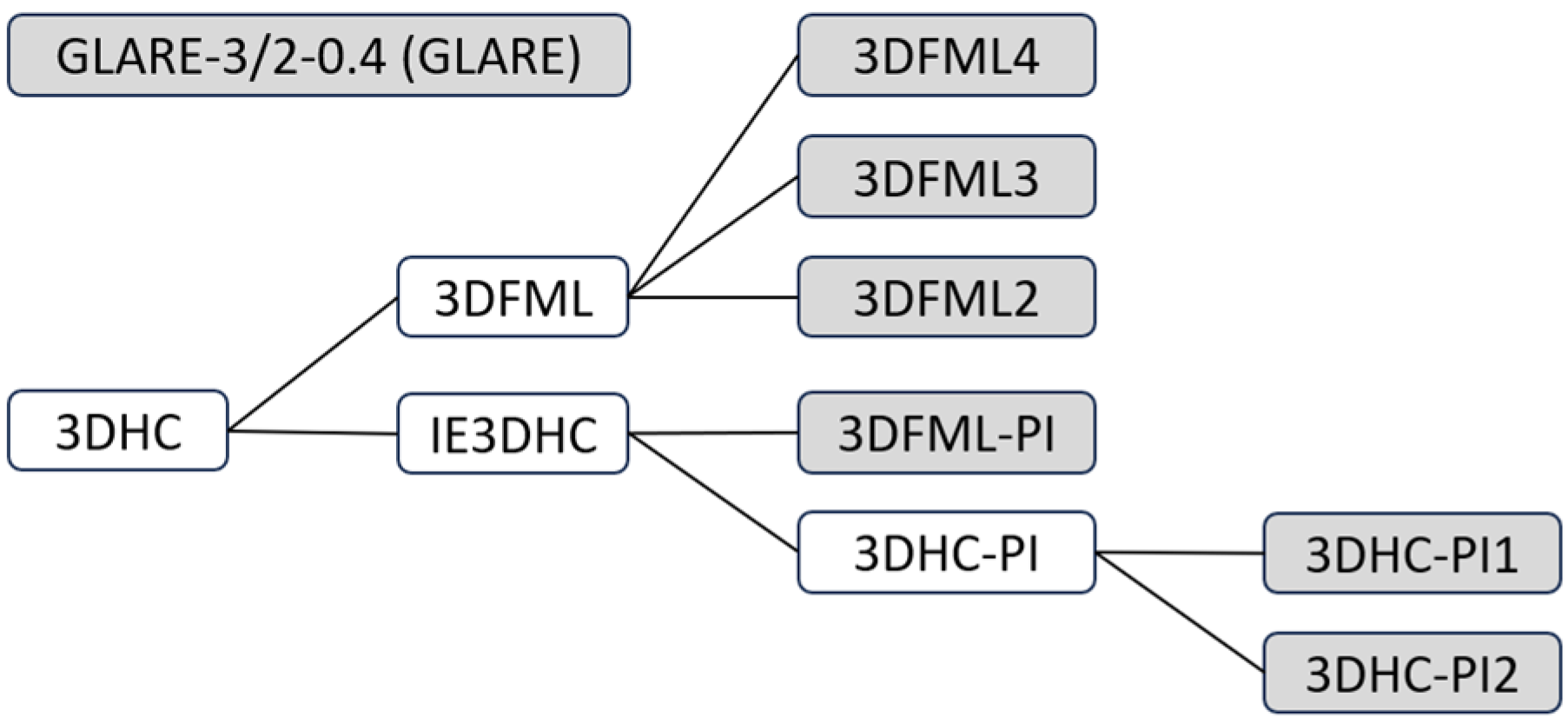
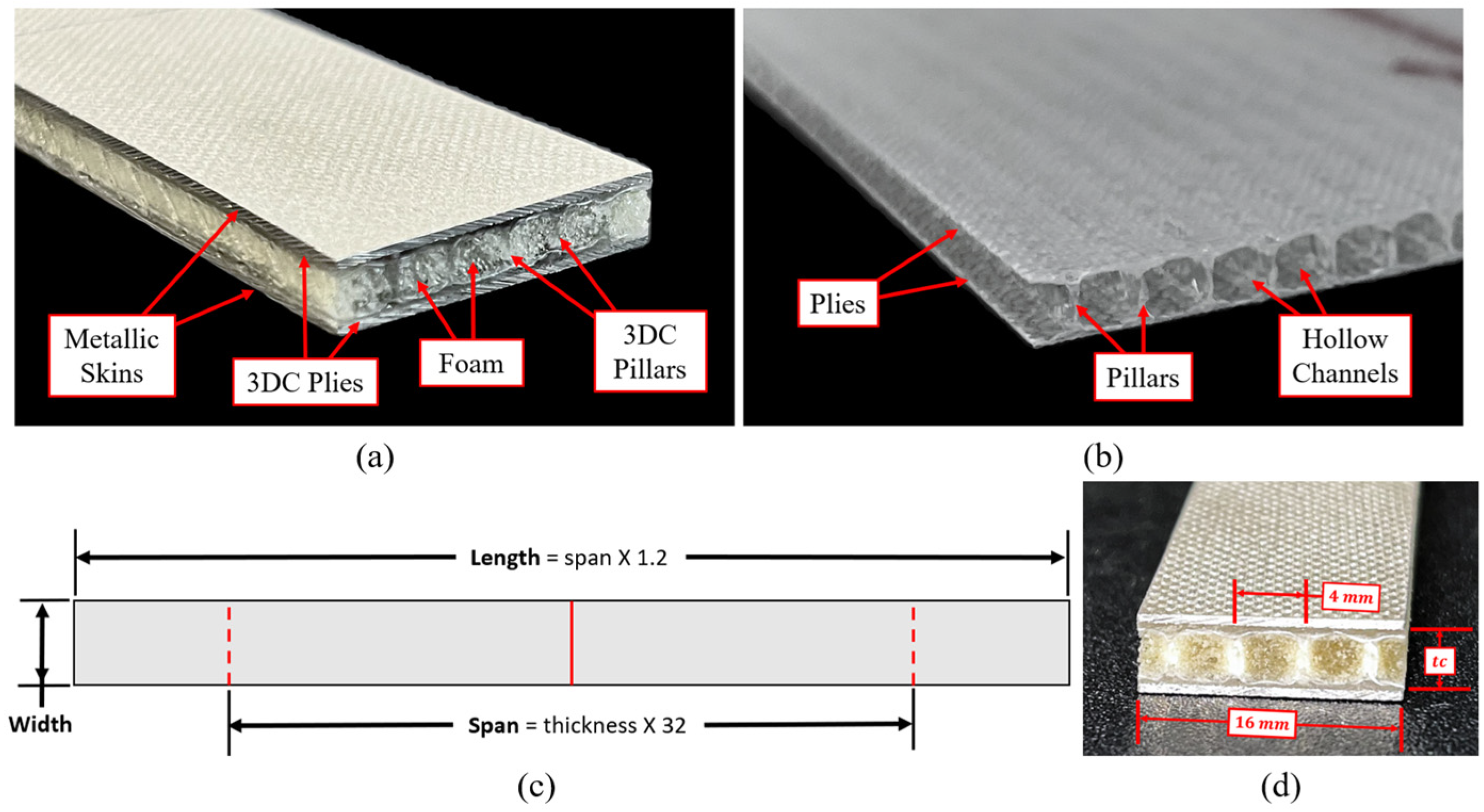

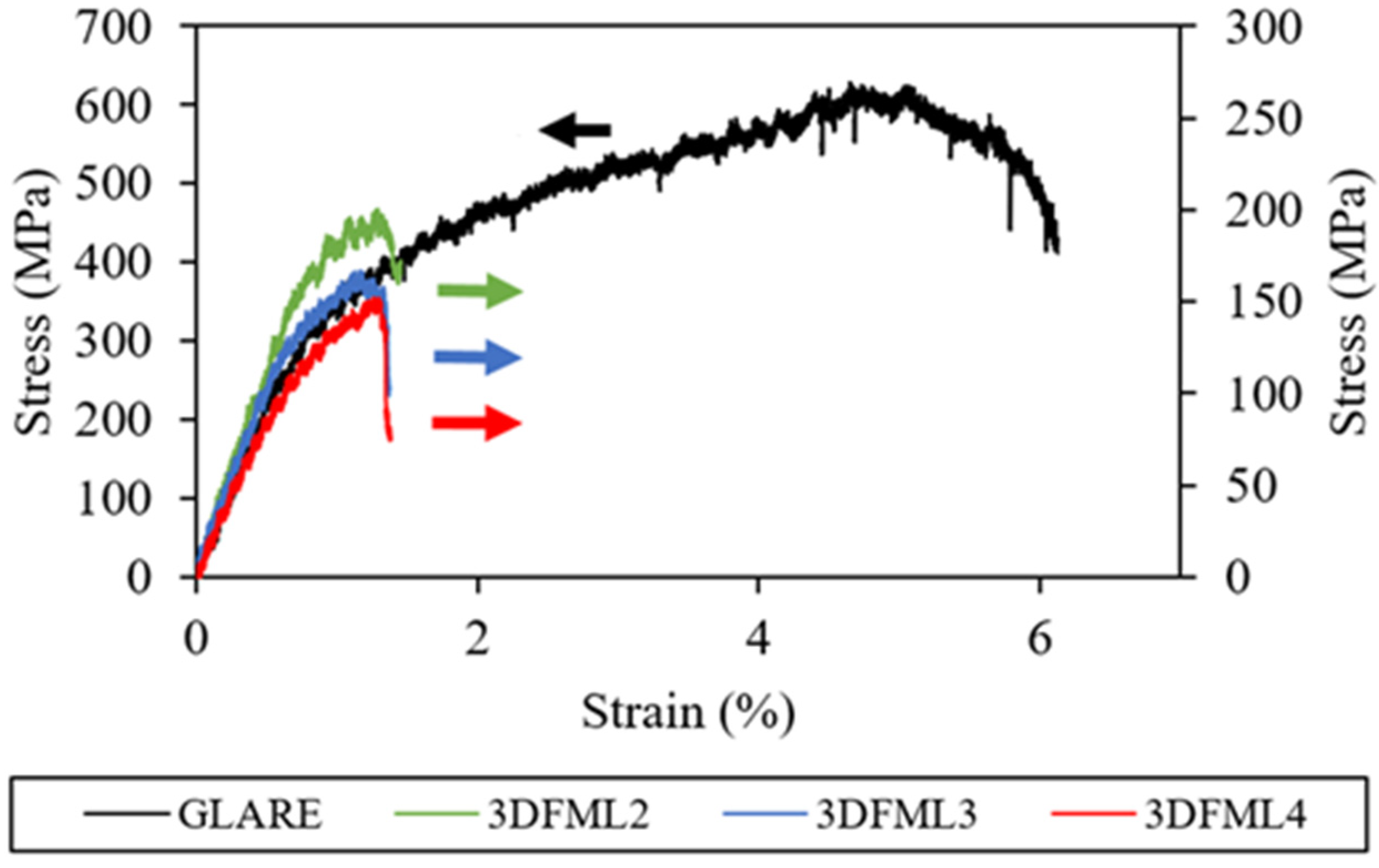

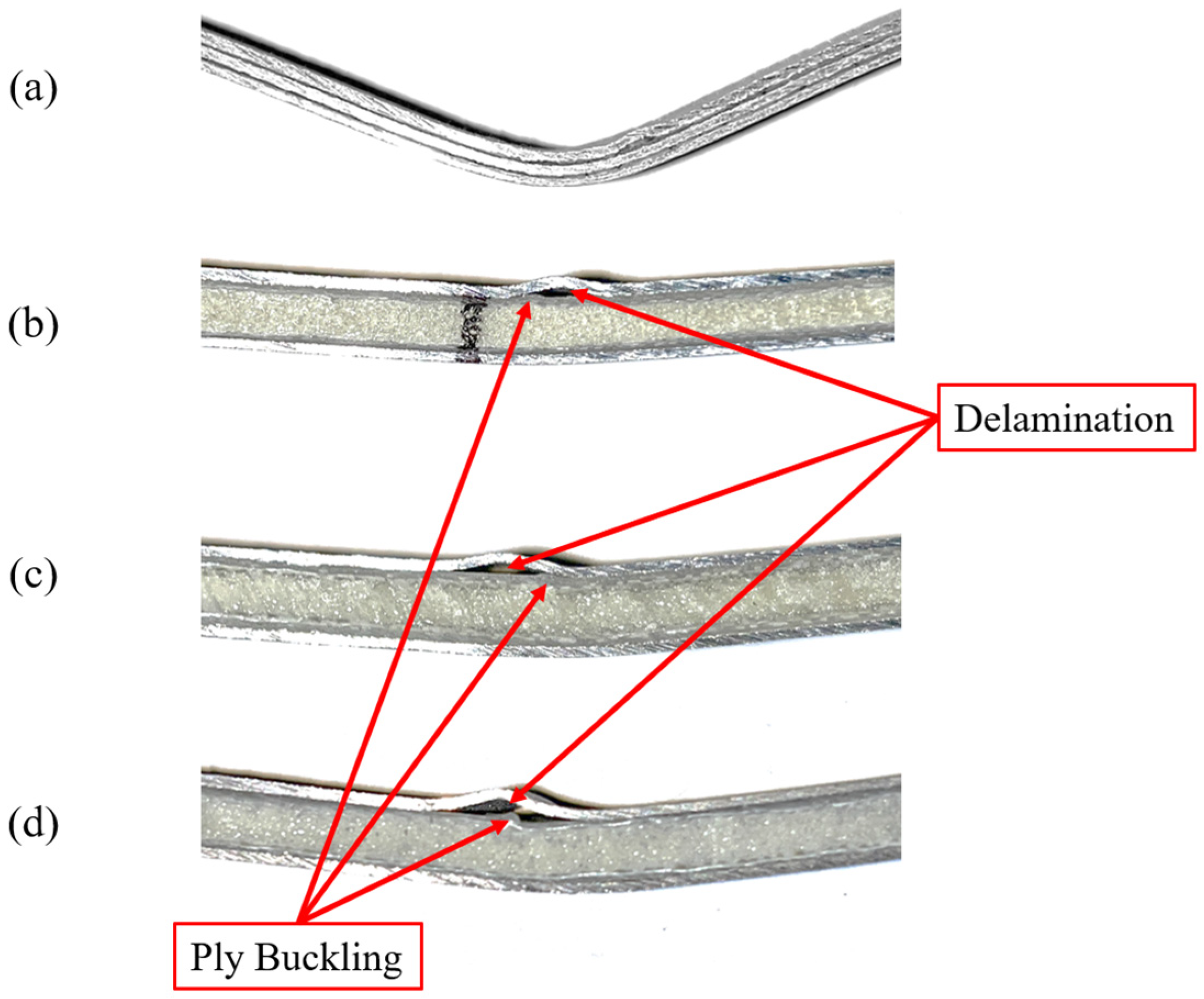
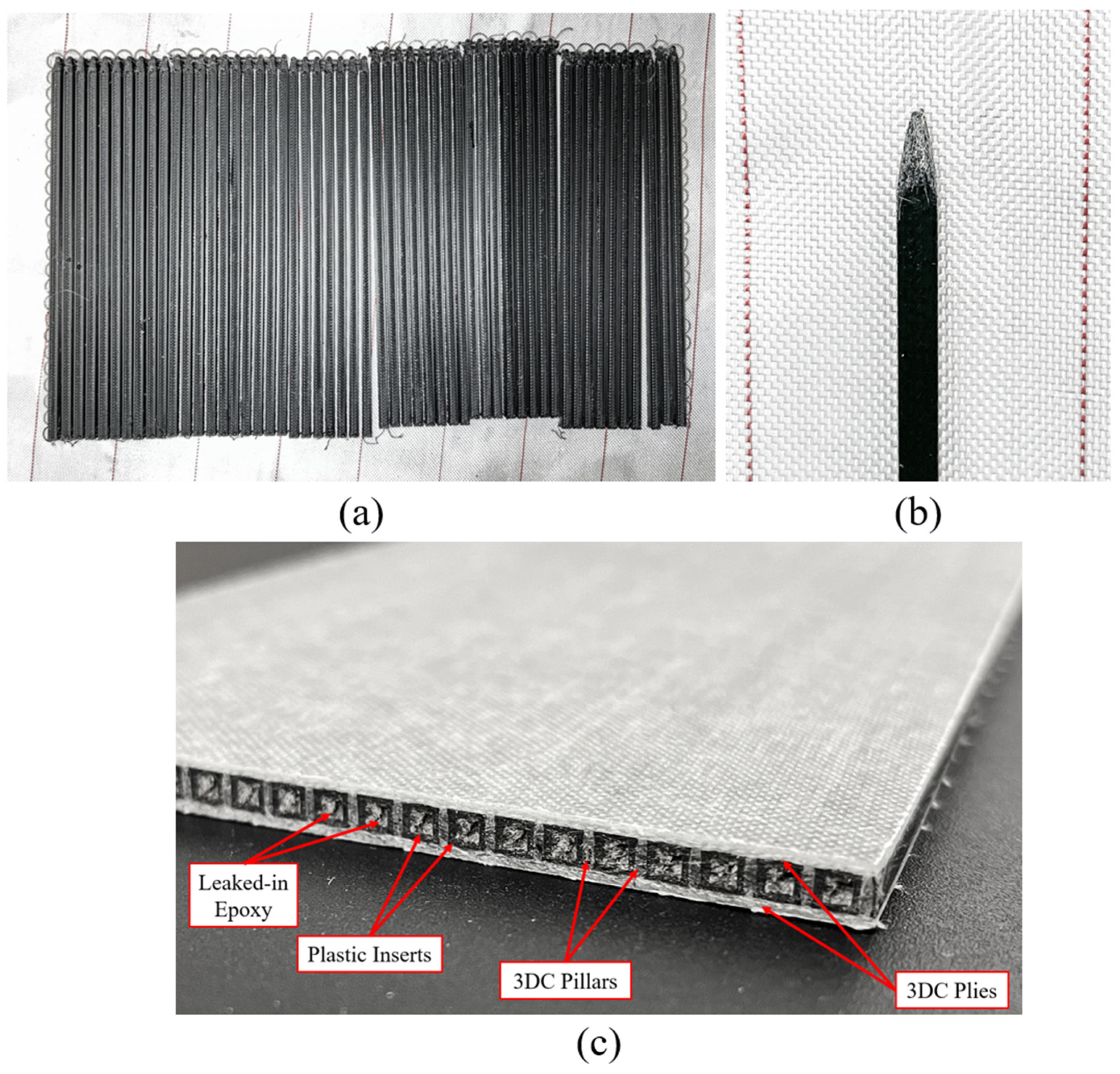


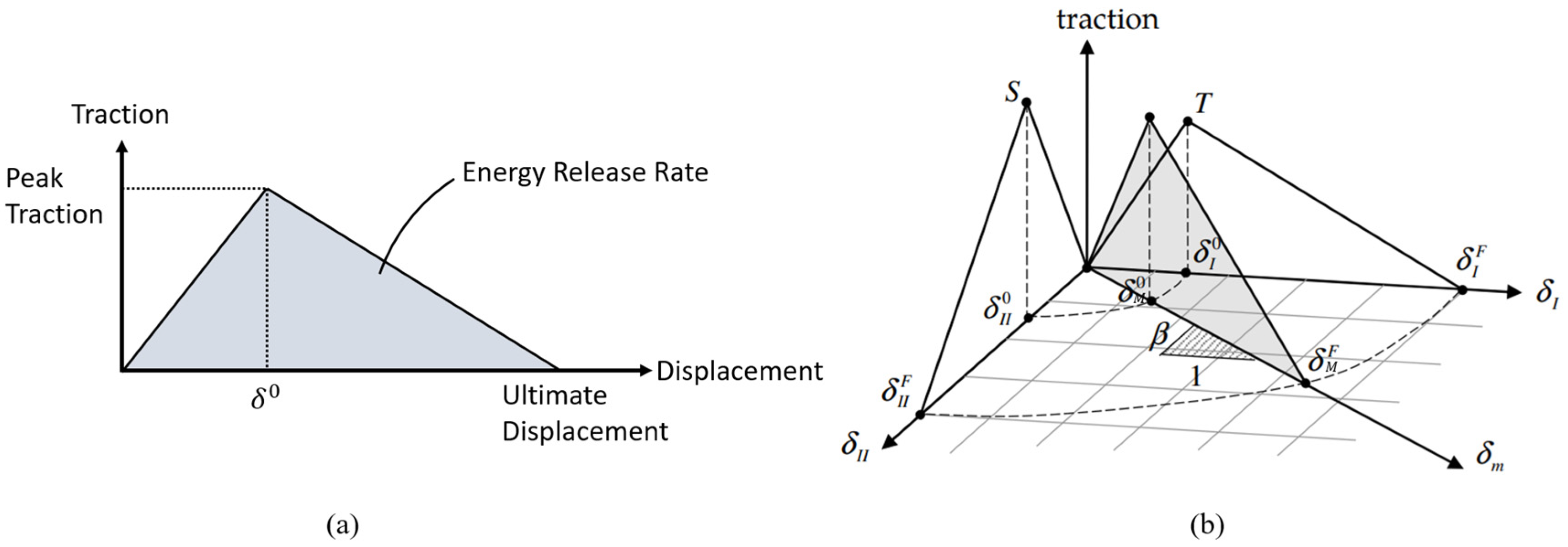

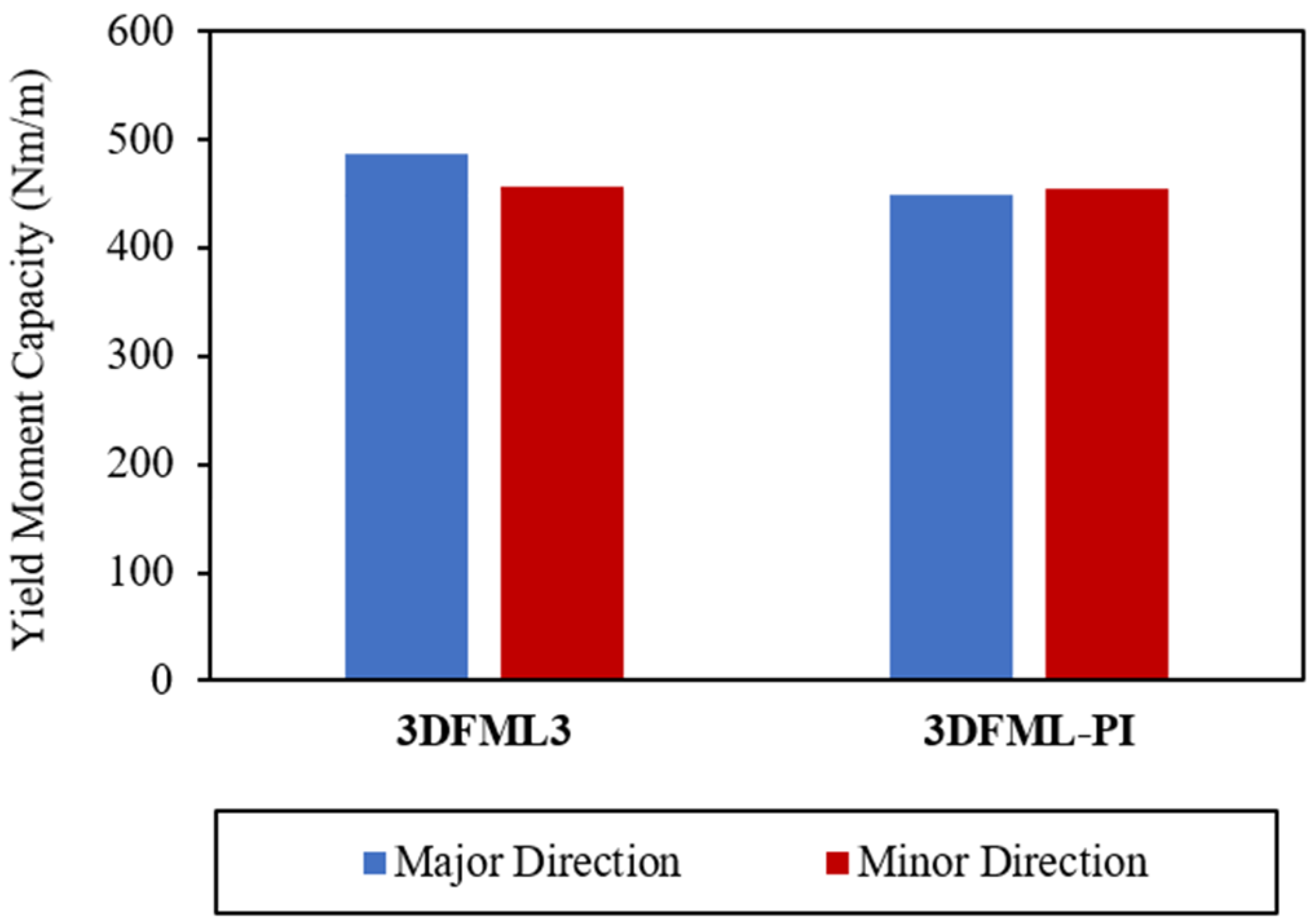

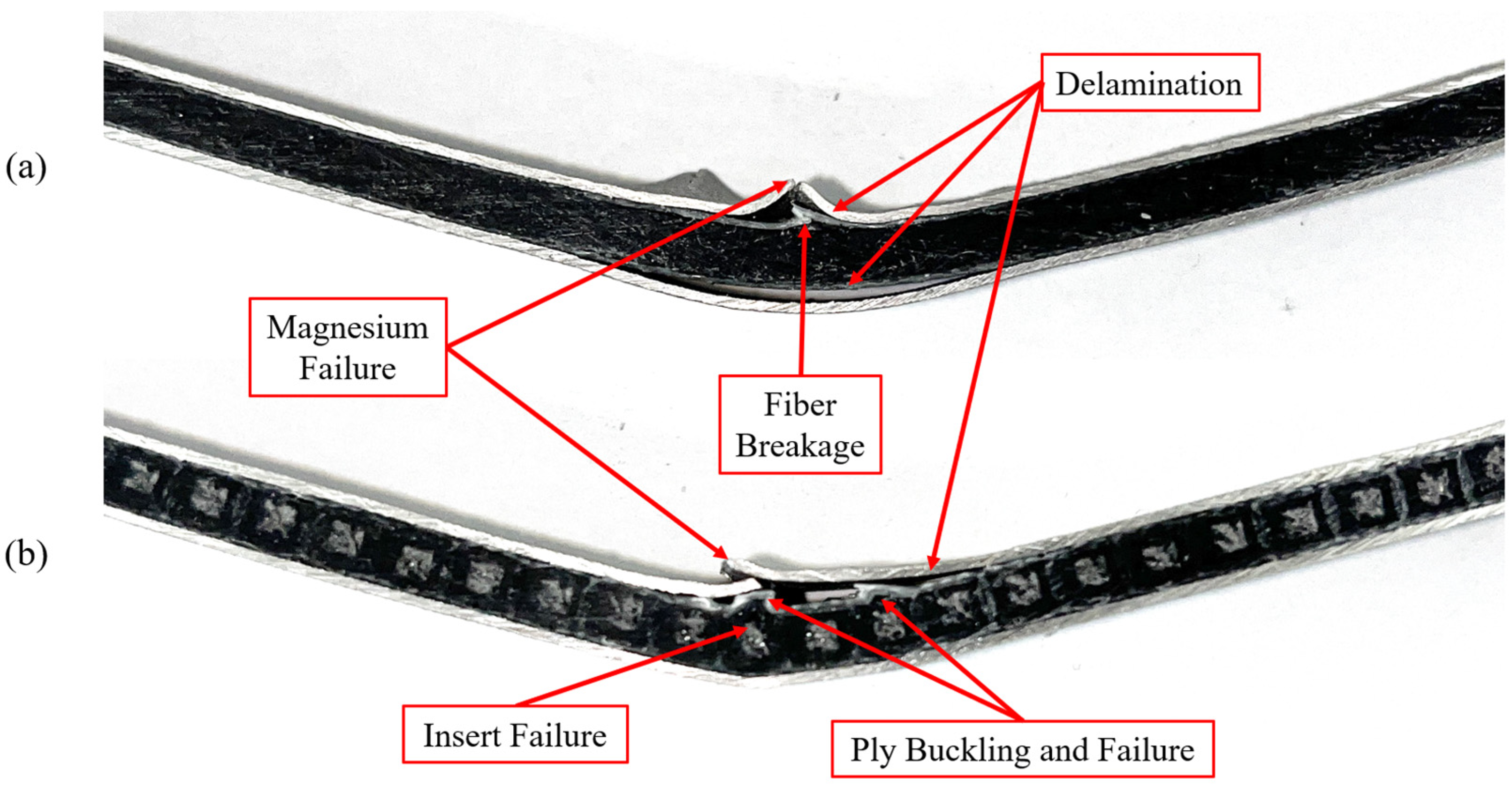
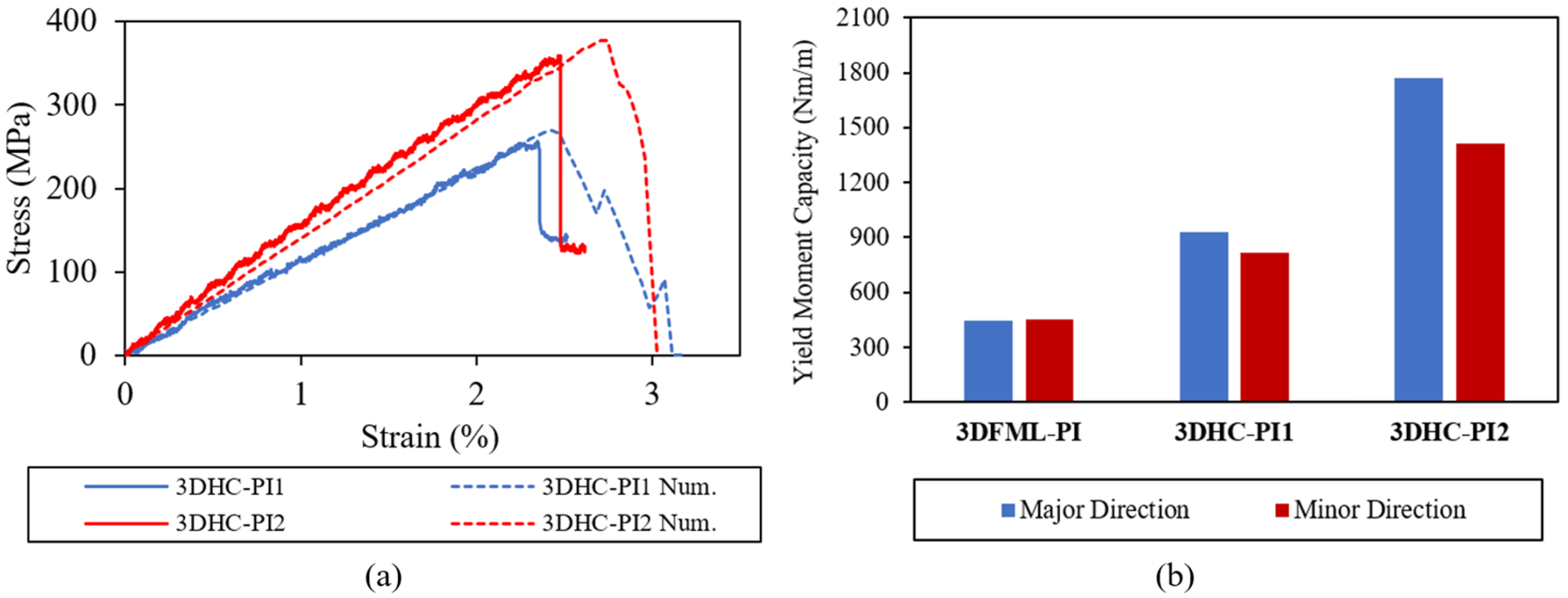
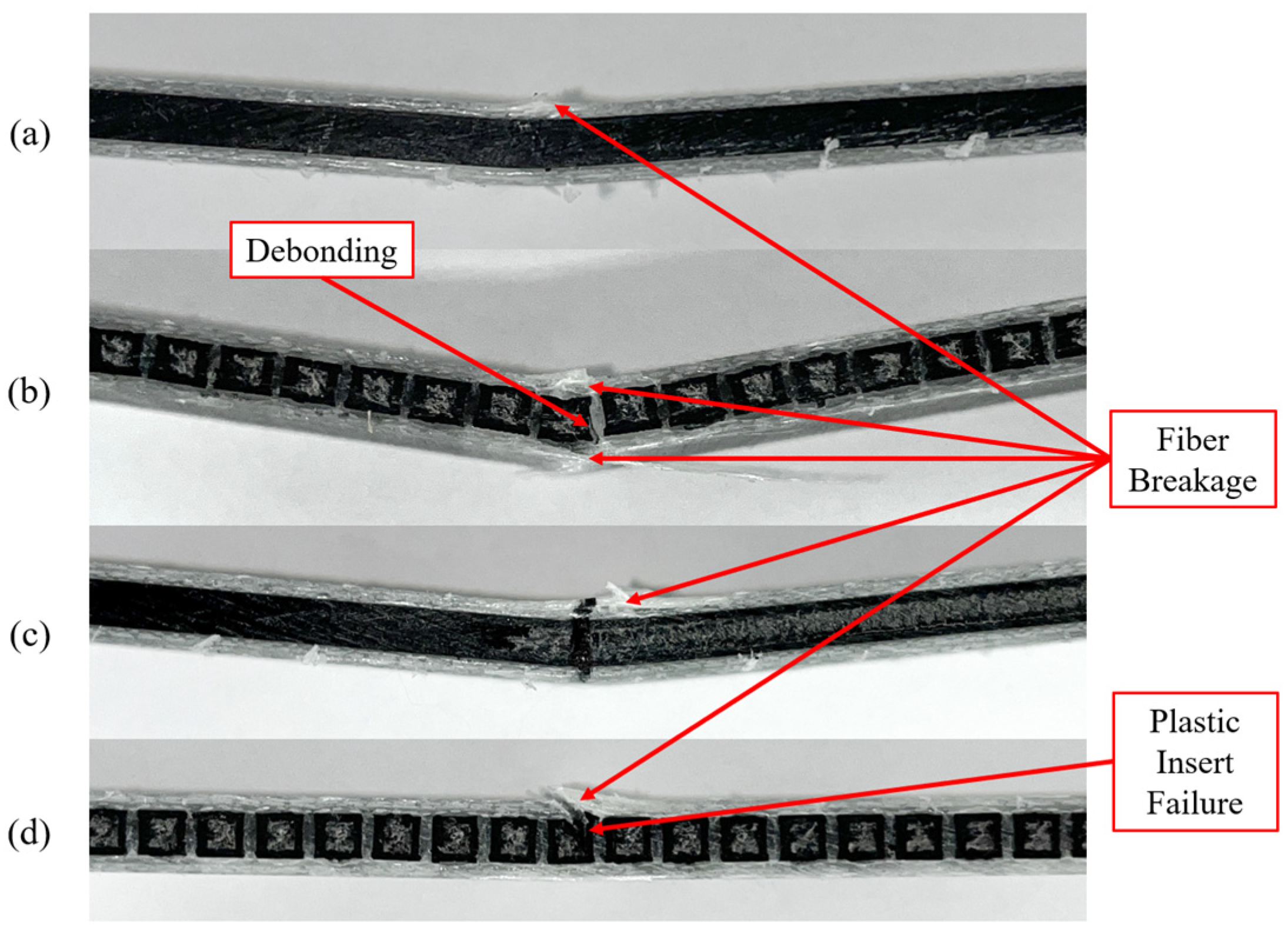
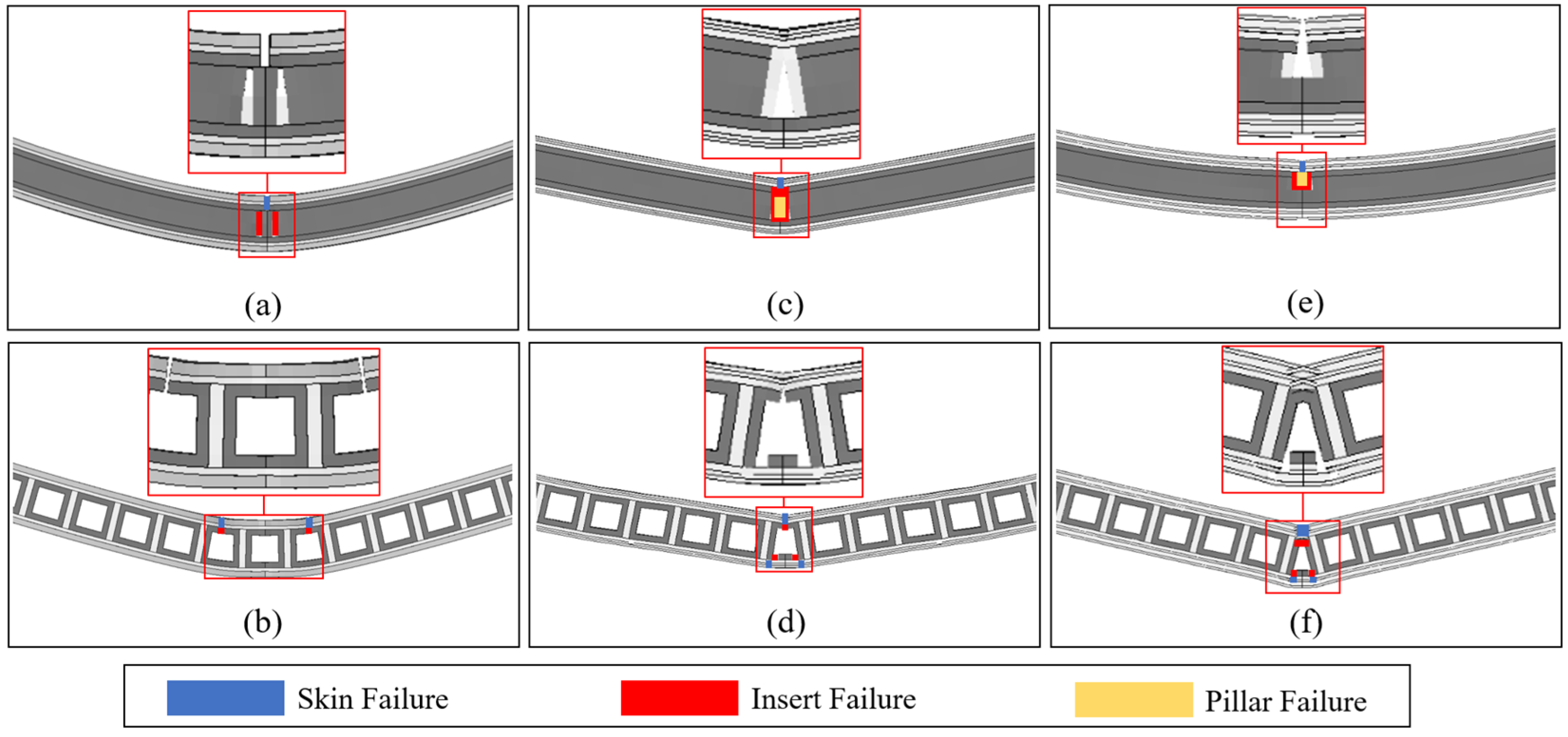
| Acronyms | Full Names |
|---|---|
| GLARE | Glass-Reinforced Laminate |
| 3DHC | 3D Hybrid Composite |
| 3DC | 3D Composite |
| 3DFML | 3D Fiber–Metal Laminate |
| IE3DHC | Insert-Enhanced 3D Hybrid Composite |
| 3DFML-PI | 3D Fiber–Metal Laminate with Plastic Inserts |
| 3DHC-PI | 3D Hybrid Composite with Plastic Inserts |
| Material Configuration | GLARE | 3DFML2 | 3DFML3 | 3DFML4 |
|---|---|---|---|---|
| Thickness (mm) | 2.27 | 4.25 | 5.15 | 5.17 |
| Areal Mass (kg/m2) | 4.64 | 4.40 | 4.45 | 4.46 |
| Material | E (MPa) | Yield Moment Capacity (Nm/m) | |||
|---|---|---|---|---|---|
| GLARE | 43.99 | 579.8 | 0.02824 | 4.855 | 165.8 |
| 3DFML2-D1 | 23.35 | 196.7 | 0.009580 | 7.376 | 341.2 |
| 3DFML2-D2 | 22.70 | 189.8 | 0.009786 | 6.622 | 296.2 |
| 3DFML3-D1 | 19.88 | 169.4 | 0.006303 | 8.124 | 486.8 |
| 3DFML3-D2 | 16.42 | 146.6 | 0.003737 | 7.021 | 457.4 |
| 3DFML4-D1 | 17.35 | 158.6 | 0.005522 | 4.906 | 377.4 |
| 3DFML4-D2 | 19.13 | 157.4 | 0.005162 | 5.941 | 347.1 |
| Density (kg/m3) | Elastic Modulus (Pa) | Poisson’s Ratio | Yield Strength (Pa) | Effective Plastic Strain at Failure |
|---|---|---|---|---|
| 1722 | 4.48 × 1010 | 0.35 | 1.36 × 108 | 0.1411 |
| Properties | 3DC Ply | 3DC Pillar | Unidirectional Glass/Epoxy * |
|---|---|---|---|
| 1750 | 1750 | 1750 | |
| 1.13 × 1010 | 3.00 × 109 | 2.93 × 1010 | |
| 1.13 × 1010 | 1.00 × 109 | 8.93 × 109 | |
| 3.19 × 109 | 1.00 × 109 | 8.93 × 109 | |
| 0.05 | 0.05 | 0.0944 | |
| 0.05 | 0.05 | 0.0944 | |
| 0.05 | 0.05 | 0.42 | |
| 1.25 × 109 | 1.00 × 109 | 2.56 × 109 | |
| 1.25 × 109 | 1.00 × 109 | 1.70 × 109 | |
| 1.25 × 109 | 1.00 × 109 | 2.56 × 109 | |
| 0.080 | 0.12 | 0.0320 | |
| 0.120 | 0.012 | 0.0925 | |
| 0.080 | 0.0108 | 0.0696 | |
| −0.080 | −0.0108 | −0.0417 | |
| 1.73 × 108 | 8.00 × 107 | 8.75 × 108 | |
| 3.46 × 108 | 8.00 × 107 | 1.46 × 109 | |
| 1.73 × 108 | 8.00 × 107 | 2.04 × 108 | |
| 3.46 × 108 | 8.00 × 107 | 6.67 × 107 | |
| 6 × 107 | 3.00 × 107 | 8.46 × 107 |
| NFLS (Pa) | SFLS (Pa) | ERATEN (J/m2) | ERATES (J/m2) |
|---|---|---|---|
| 5.90 × 107 | 2.30 × 107 | 1500 | 2000 |
| PARAM | CT2CN | CN (Pa) | |
| 1 | 0.4286 | 3.5 × 1012 |
| Configurations | 3DFML3 | 3DFML-PI | 3DHC-PI1 | 3DHC-PI2 |
|---|---|---|---|---|
| Thickness (mm) | 5.17 | 5.12 | 4.72 | 5.47 |
| Areal mass (kg/m2) | 4.45 | 5.88 | 5.26 | 6.32 |
| Configurations | E (GPa) | |||
|---|---|---|---|---|
| 3DFML-PI-D1 | 21.08 | 227.2 | 0.03060 | 6.828 |
| 3DFML-PI-D2 | 21.21 | 198.6 | 0.01153 | 6.550 |
Disclaimer/Publisher’s Note: The statements, opinions and data contained in all publications are solely those of the individual author(s) and contributor(s) and not of MDPI and/or the editor(s). MDPI and/or the editor(s) disclaim responsibility for any injury to people or property resulting from any ideas, methods, instructions or products referred to in the content. |
© 2023 by the authors. Licensee MDPI, Basel, Switzerland. This article is an open access article distributed under the terms and conditions of the Creative Commons Attribution (CC BY) license (https://creativecommons.org/licenses/by/4.0/).
Share and Cite
Wang, K.; Taheri, F. Comparisons of the Performance of Novel Lightweight Three-Dimensional Hybrid Composites against GLARE Fiber–Metal Laminate. Processes 2023, 11, 2875. https://doi.org/10.3390/pr11102875
Wang K, Taheri F. Comparisons of the Performance of Novel Lightweight Three-Dimensional Hybrid Composites against GLARE Fiber–Metal Laminate. Processes. 2023; 11(10):2875. https://doi.org/10.3390/pr11102875
Chicago/Turabian StyleWang, Ke, and Farid Taheri. 2023. "Comparisons of the Performance of Novel Lightweight Three-Dimensional Hybrid Composites against GLARE Fiber–Metal Laminate" Processes 11, no. 10: 2875. https://doi.org/10.3390/pr11102875
APA StyleWang, K., & Taheri, F. (2023). Comparisons of the Performance of Novel Lightweight Three-Dimensional Hybrid Composites against GLARE Fiber–Metal Laminate. Processes, 11(10), 2875. https://doi.org/10.3390/pr11102875






